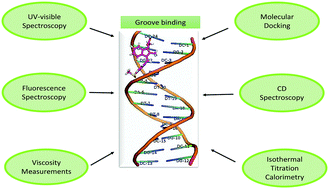Elucidating the interaction of sulindac with calf thymus DNA: biophysical and in silico molecular modelling approach†
Abstract
Sulindac is one of the most effective non-steroidal anti-inflammatory drugs (NSAIDs) and belongs to the arylalkanoic acid class. DNA is the major target for a wide range of therapeutic small molecules. Thus, deciphering the interaction of drugs with DNA not only offers insights into the rational design of novel and more efficient drugs targeted to DNA, but it also gives an opportunity for developing effective therapeutic agents for the control of gene expression. In the present study, we have attempted to establish the mode of binding of sulindac with calf thymus DNA (Ct-DNA) through various spectroscopic studies and molecular modelling. UV-visible absorbance and steady state fluorescence experiments revealed a binding constant in the order of 103 L mol−1, which is consistent with well-known groove binders. A series of experiments such as competitive displacement assays, iodide quenching, DNA melting study, CD spectral analysis and viscosity measurements were performed to confirm the binding mode. The isothermal calorimetry results were consistent with the groove binders and confirmed that the formation of the sulindac–Ct-DNA complex is spontaneous and enthalpy (ΔH < 0) driven. This is further supported by the consistent results obtained from the in silico molecular docking studies.



 Please wait while we load your content...
Please wait while we load your content...